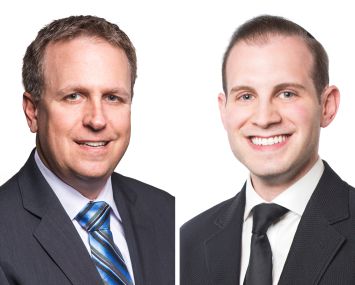All-Pro: CBRE’s Millon and Traynor Are Shaking Up the Large Loan Space
By Cathy Cunningham January 8, 2019 9:00 am
reprints
You could say that without the effort of James Millon instant replay might’ve never been implemented in Big Ten college football.
The date was Oct. 12, 2002, and Penn State University was going head to head against its fierce competitor, the Michigan Wolverines. With under three minutes left in the third quarter, Penn State was winning 13-7 when the team’s defense forced a Michigan punt at the 20-yard line. Millon—a Penn State defensive back—blocked the punt but referees called a penalty for roughing the kicker on the play, which gave Michigan the ball back. Michigan ended up scoring to put them up 14-13 with 14 minutes left in the fourth quarter, and eventually went on to win 27-24 in overtime. A heated debate around whether or not Millon actually hit the kicker immediately ensued, which was hotly contested but couldn’t be independently assessed. And that’s one moment in time that helped push the Big Ten Conference to realize an instant replay system was needed. Had it been available, it would have been evident—many say—that Millon did not, in fact, commit the penalty.
Fast forward 16 years, and Millon, 38, is playing on different turf, heading up CBRE’s New York debt and structured finance platform together with Tom Traynor, 49. The two were previously in Deutsche Bank’s large loan commercial real estate originations and capital markets businesses (Traynor was a managing director, and Millon a director) before moving to CBRE two years ago, exploding out of the gate with an end-zone-dance-worthy $1.75 billion debt package for HNA Group’s $2.2 billion purchase of 245 Park Avenue in May 2017.
Darcy Stacom and Bill Shanahan, the heads of CBRE’s investment sales platform, had been hard at work on the trophy asset’s sale mandate. When HNA was identified as the buyer, Millon and Traynor moved quickly to negotiate and close the mammoth deal, led by J.P. Morgan Chase. Cooper-Horowitz co-brokered the debt.
“I had a lot of sleepless nights coming over here because it was a different business model,” Millon said of his pre-move jitters.
But Millon and Traynor’s brokerage debut showcased their deep roots in lending and finesse in structuring deals effectively and quickly, as well as their wherewithal.
“If you’ve been on the principal lending side then you understand the risks that the big broker dealers are taking when they underwrite loans,” said Joseph Geoghan, the head of CMBS originations at J.P. Morgan Chase. “Brokers who haven’t sat on the principal lending side don’t understand the risk that an institution takes when it makes a loan like 245 Park Avenue, which was 80 percent loan-to-value, tightly priced and had a tight timeframe. James and Tom understand the principal risk-taking business that we are in, and that makes them a more complete package as a broker.”
As if one monster loan wasn’t enough to contend with, Millon and Traynor were working on the $1.1 billion financing for Stonemount Financial Group’s $1.3 billion acquisition of net-leased real estate across 20 states from Oak Street Real Estate Capital at the same time 245 Park was underway.
Their move to CBRE filled a specific need and brought about a marked platform change: The brokerage had primarily focused on arranging loans of less than $100 million and was now ready to move into the large-loan space.
“Bill and Darcy were prolific on the investment sales side,” said Dennis Schuh, the chief originations officer at Starwood Property Trust. “But for some of the really large transactions they were involved in, the debt assignment was getting awarded to one of the other brokerages. I think James and Tom saw that as a real opportunity, and they had the experience and skill set from working on large loan transactions at Deutsche Bank.”
The fact that Millon and Traynor have spent the bulk of their careers knee-deep in mortgage documents gives them a distinct competitive edge, Stacom said: “That brings a greater understanding of the elements of a mortgage that are not purely financial. This is an area that the debt industry has long been lacking and I can tell you our clients are grateful to see it filled.”

Nevertheless, not every part of the transition was easy.
“It took us 12 months to say the word ‘broker,’ ” Millon admitted. “But Mary Ann Tighe, [the CEO of CBRE’s New York Tri-state region], taught us to own it.” (“I say it with pride!” Tighe said with a laugh.)
“Without a doubt they are strengthening our platform,” Tighe said of Millon and Traynor. “Not only through their deep knowledge of the capital markets universe, but through their natural ability to partner. We’re able to ask, ‘If this lease happens, what will that do to the capital structure of the asset?’ That’s an enormously powerful tool in a negotiation. They’re helping us to think like owners and investors in real estate. They make us all smarter.”
The 245 Park deal can’t have been an easy act to follow, but the heady momentum has continued. In their two years at CBRE, Millon and Traynor have arranged several high-profile financings, including a $650 million loan for L&L Holding Company and Normandy Real Estate Partners’ $880 million acquisition of Terminal Stores in November 2018.
“On Terminal Stores, they were asked to place a significant amount of debt on a property with little existing cash flow,” Stacom said. “The remarkable upside in this transaction is a story that only sophisticated debt experts can tell successfully. The transaction closed ahead of schedule with excellent terms for the borrower.”
Walton Street has competed on loans that Traynor and Millon have brokered in addition to engaging them as a borrower to arrange debt. “They understand from a borrower’s perspective what’s important, but I think what’s equally important—and what they offer the market—is they also understand the lender perspective because they were lenders for so long,” Richard Ratke, a senior princial at Walton Street, said. “They know the market and can help coach borrowers, in terms of what’s an aggressive ask and what is reasonable. I think they have a very fair, balanced approach and they’re always available.”
“It’s not an ‘odd couple’ type of relationship,” Schuh said. “They have similar personalities and skill sets and and are able to leverage each other as opposed to having one person get over-extended. It is somewhat unique. Usually it’s a senior person with a really talented right-hand man or woman; they are partners and equals.”
The two New Jerseyans first joined forces when Millon joined Deutsche Bank in 2012. Traynor had been at the bank since the late 1990s.
Traynor grew up in Mendham, N.J. He graduated from the University of Notre Dame’s business school with an eye on investment banking, when Deutsche Bank was in growth mode. Its name at the time was Deutsche Morgan Grenfell, having acquired U.K. merchant bank Morgan Grenfell in 1989, but its nickname on the Street was “Deutsche Merrill Goldman,” because of its reputation for looting top talent from its competitors’ trading desks.
One such group had been hired from Goldman Sachs to start the bank’s commercial real estate debt group when Traynor joined as a summer associate in 1997. On his first day, Traynor sat in on a meeting with developer Harry Macklowe. “It was an entertaining meeting,” Traynor recalled. “That got me thinking about what I wanted to do. The whole deal side was really intriguing to me; the type of deals they were doing and the sponsors they were working with.” The commercial mortgage-backed securities group was also growing and asked Traynor to come onboard. “I was sprinting from then until the Russian default crisis, which was a huge dislocation at the time.”
After the global financial crisis came the recession, and Deutsche Bank switched from originating loans to asset management—although only for a short period of time thanks to an opportunistic play.
“[The bank] took a pocket of money from Europe and moved it to the U.S.—which they felt was the safest place to invest in at the time—and they let us run with it,” Traynor said. At the time, Lehman Brothers had failed and Bear Stearns had been absorbed, leaving the institutions’ clients in limbo. “For me that was an opportunity to go to the West Coast, expand my relationship Rolodex and do some interesting deals,” he said. “We were very quickly short-staffed, and there is only so much a first- or second-year analyst can do so we needed someone to hit the ground running”
Enter, Millon.
The Wayne, N.J. native joined Deutsche Bank from Société Générale (SocGen). A first-generation financier, his parents are in the medical field. “I was always interested in finance and Wall Street,” he said. “For me, real estate was a really nice marriage between capital markets and the sticks and bricks of everyday life.” His first job after grad school was at MMA Realty Capital—a mezzanine fund—before joining SocGen’s CMBS group in 2007.
Like today, the pre-crisis market of 2006 and 2007 was awash with liquidity. “People were doing things that were reckless from a lending perspective and it didn’t seem to matter because there was always liquidity to refinance you out, or an exit through some securitized product,” Millon said.
Thankfully, “[today’s] capital markets are choppy, but I don’t see the reckless approach we saw in the mid-2000s in terms of underwriting and people taking ridiculous credit risks,” Millon said.
When the crisis hit, Millon was an associate on SocGen’s trading desk. “I saw something that I hope nobody has to relive ever again,” he recalled. “In one day 50 percent of the desk was emptied out. My group was a 10-person team, they kept two of us and let everyone else go, so I and another individual were tasked with doing things we had no idea how to do—from sitting in a monthly mark-to-market meeting and deciding how much of a mark to take that month, to hedging, to loan sales—all of it. We learned a ton and while the knowledge was wonderful and I’m happy I did it once, I don’t need to do it again.”
Traynor and Millon’s paths had crossed via the large loan floating-rate deals that were brought to market pre-crisis, with Deutsche Bank typically leading and SocGen participating. Post-crisis, when it was evident that SocGen wouldn’t be getting back into the real estate business anytime soon, Millon interviewed with Deutsche Bank.
“He had long hair at the time,” Traynor remembered.
“But I worked at a French bank, so you could do that stuff!” Millon protested.
Millon joined at an opportune time. CMBS had started to come back and Traynor’s group was doing a lot of special-situation deals. “Our volume started to pick up because of the weight that he could carry,” Traynor said.
But Millon’s ease of transition may have belied his apprehension.
“It was the second time in my life when I really questioned whether I belonged, because the talent level was so high that you were surrounded by rock stars,” he said. “The analog to that is when I was a freshman at Penn State and going up against all-Americans. But once you have a couple of wins you get your confidence back.”
“We were absolutely happy at Deutsche Bank; we were doing a ton of deals and had a great client base,” Traynor said. “We weren’t looking to leave.”
But, opportunity came knocking when CBRE wanted to move its debt and structured finance program into the large-loan space and couldn’t find a fit at other brokerages so started looking at the investment banks instead.
As institutional lenders, Traynor and Millon had witnessed the rise of the debt broker post-crisis. The lack of liquidity had opened doors even wider for those brokerage houses as even the big institutional players began going through intermediaries to place their loans.
“We knew it was a very viable opportunity and on the rise, and that the platform we were joining was the best in the industry,” Traynor said.
Tim Doherty, the head of ground lease investments at iStar (and a borrower client of Millon and Traynor’s at both Deutsche Bank and CBRE) said: “Deutsche Bank is a powerhouse investment bank and their Rolodexes were pretty impressive. In going to CBRE they could utilize those Rolodexes as well as their expertise as long-time lenders. I raised my eyebrows a little when I first heard as it was unexpected, but when I sat back and thought about it, it was a pretty powerful move.”
Ratke also understood the rationale: “More often than not in the mortgage brokerage community individuals have just been on the brokerage side for the duration of their career and haven’t spent time lending money or negotiating points as a lender. Right off the bat I thought the move could be good for us [at Walton Street] because they bring that value-add perspective.”
While the two once knew exactly what could be done from a financing standpoint within the four walls of Deutsche Bank, they now have the full arsenal of every capital source in the market. “That’s really fun—having an inventory of lenders behind us,” Millon said.
Millon and Traynor sit in CBRE’s 200 Park Avenue office—their office is set up as a trading floor to encourage open communication among their team of seven—but their reach is national.
“That’s really important to the sponsors we cover,” Traynor said. “We cover the top 50 guys and they don’t play in just one MSA; they’re playing everywhere.”
In March 2018, New York developers Waterbridge Capital and Continental Equities engaged Millon and Traynor to source $500 million in financing for their redevelopment of The Museum Building—a 1.1-million-square-foot mixed-use project in Downtown Los Angeles. In August, Starwood Property Trust provided a $213 million 18-month bridge loan on the property to recapitalizes a $165 million predevelopment loan provided by Jamestown in 2016.
“I think they have a good appreciation for what lenders are able to do and are able to communicate that effectively back to their clients,” Schuh said.
Also in August 2018, they arranged a $192 million acquisition loan on behalf of Chicago-based Walton Street Capital and Crocker Partners for their purchase of The Landing at MIA, an office and industrial portfolio adjacent to Miami International Airport. Deutsche Bank provided the loan.
“It was a really great execution and we couldn’t be happier with how it went,” Ratke said. “If ever they’d be conflicted it would have been [in that transaction] because a lot of their former colleagues were providing the loan, but they ran a great process and got us the most competitive lender with the most competitive terms.”
Roger Morales, the head of KKR’s commercial real estate acquisitions in the Americas, said that their lending background is “100 percent” apparent in their approach to deals: “They also have deep-standing lender relationships that allow for offline calls to help me evaluate how to think about the debt while we price the transaction in advance of engaging them.”
Morales hired CBRE to arrange debt on two transactions recently, including the acquisition of a portfolio of infill last mile industrial assets in Houston and Dallas and the $250 million purchase of the Sabadell Financial Center in the Brickell part of Miami.
“We got the best deal that was available in the market in both circumstances; they outperformed the initial indication of terms on the debt,” Morales said.
Millon said that Deutsche Bank’s Matt Borstein taught them a mantra that has stuck with them in their new role: A.B.I (Always Be Issuing). ”That’s the only way you have real price discovery from an investor perspective. Today, that translates into the lender perspective for us; we need to have all of those touch points, because it gives us the opportunity to talk to various groups and see where things are shaking out. It gives us a very strong market perspective.”
As such, Millon and Traynor aim to have $1.5 billion to $2 billion in the market at any time across executions, whether it’s ground-up construction, single-asset, single-borrower CMBS, conduit CMBS, life company or bank deals.
No mean feat, but the tight-knit team they have put together has their backs. Last year, the group embarked on the Whole30 clean-eating diet. The “tiger blood” phase, in which energy returns after a cold turkey on toxins, left them “bouncing and ready to go,” Traynor said and laughed.
Tiger blood or not, it’s safe to say that this team has no signs of slowing down any time soon.


